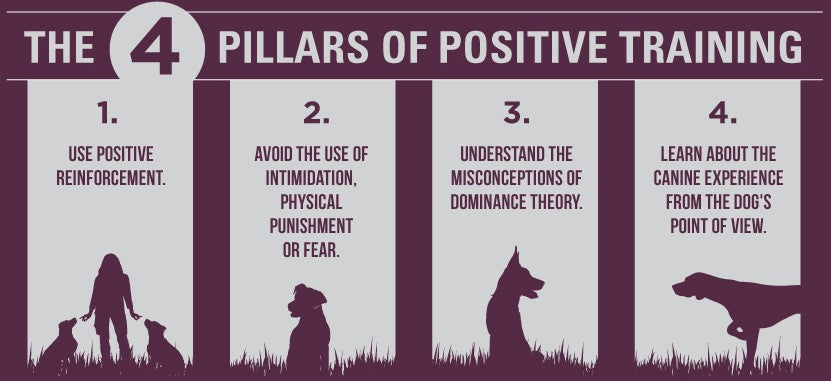What is positive dog training, exactly?
Positive training is rewarding your dog for what she or he is doing correctly versus punishing him for what they are doing wrong. Focus on correcting the dog for the negative behavior by redirecting and showing them what you are actually expecting from them. Forceful negative correction confuses and overwhelms the dog and can possibly lead to fear and even aggression.
Consider this example. You catch your new puppy peeing on your floor and you hit them or rub their nose in it. IF your pup understands what they did wrong when you punish them, all they are learning is to be afraid to do it again.
Did you achieve the results that you desired? Possibly, but you also taught them to fear you and they still don't know WHERE they were supposed to go. The alternate approach, also considered positive training, when you catch your puppy peeing on the floor, immediately take them outside. When they go to the bathroom outside, reward them for doing what you expected. Rewards can be treats, throwing a ball, playing tug-of-war, etc. In the end, they learned where they are supposed to go versus where they are not supposed to go.
When you use a positive approach, your dog is better able to understand what you expect of them and more willing to repeat it because they know that they will be rewarded for it. They also learns that they can trust you which can strengthen the bond, loyalty and love you share for each other.
Did you know that trainers of bomb sniffing dogs, guide dogs, search and rescue dogs, therapy dogs, as well as dogs used for police and military tasks are now using positive reinforcement training? They have found that it is a faster and more effective way of developing desired behaviors.
One of the most frustrating things that most dog parents have to deal with, at some point, is leash training. Dogs love to be outside which is both exciting and stimulating for them. The urge for them to pull takes over because they are so excited and their nose is in overdrive. Dogs that have a bad habit of pulling continue to do so because, essentially, they are being rewarded for this behavior. Obviously, this is not something that you are consciously rewarding but in the end, the dog pulls you until they get to where they want to go. Choke chains and prong collars are not recommended because they can damage the dog’s trachea and a lot of times the dogs become de-synthesized to the pain.
The most humane and effective tool you can use to help end pulling is a harness. Harness sit low enough that it does not damage/harm the trachea and high enough that it doesn’t restrict the dog’s shoulder muscles.
Here a few pointers to help you get started:
- Connect the training leash to both the front and back of the harness. This helps evenly distribute the pressure points making it safe and comfortable for your dog.
- Begin your walk and keep in mind that your goal is to have a loose leash at all times. When your dog pulls, the control loop on the back of the harness will gently tighten around his chest to get his attention. They should stop and turn around and look at you.
- Once they stop, you do not want to continue the walk until there is slack on the leash. This is a great time to introduce treat training, as well. You want to wait until you have a loose leash to reward them. If they resist or become a reactive puller (squirrels, cats, other dogs, etc.) and you are not able to get a loose leash then turn your dog around and walk in the opposite direction.
Boredom can play a huge role in many dogs’ behavior issues. Training is a great way to curb that boredom because they are being both mentally and physically stimulated. Daily walks are also crucial in helping to keep your dog interactive and healthy.
Keep in mind, the most common issues with positive reinforcement training are timing and consistency. Make sure that you are rewarding correct behavior as soon as it happens and stay consistent. Use the same cue words every time and most importantly, don’t give up and quit. Bad habits are not created in a day so it can take some time to achieve the good behavior that you are looking for.
Most importantly and last but not least, positive reinforcement training should always be upbeat and fun for both you AND your dog. It will all be worth it in the end. All your dog wants is to make you happy and in turn he will be happy as well. It’s the least you can do for him, he deserves only the best!
Be sure to check out our training classes and products to help you and your companion succeed!

